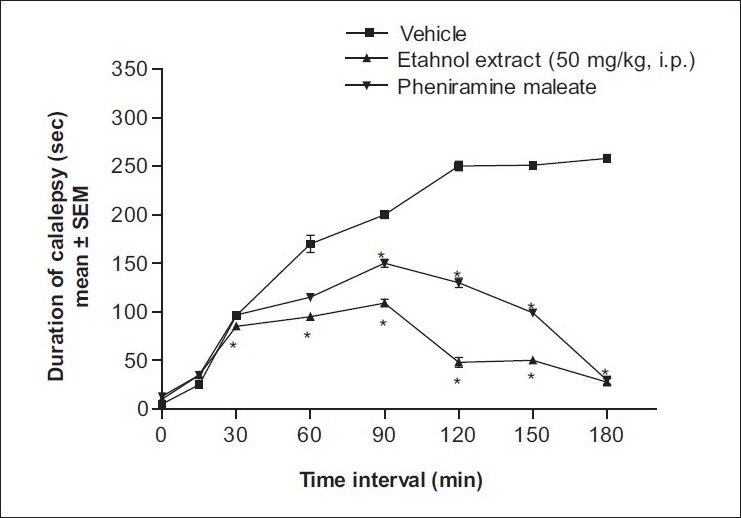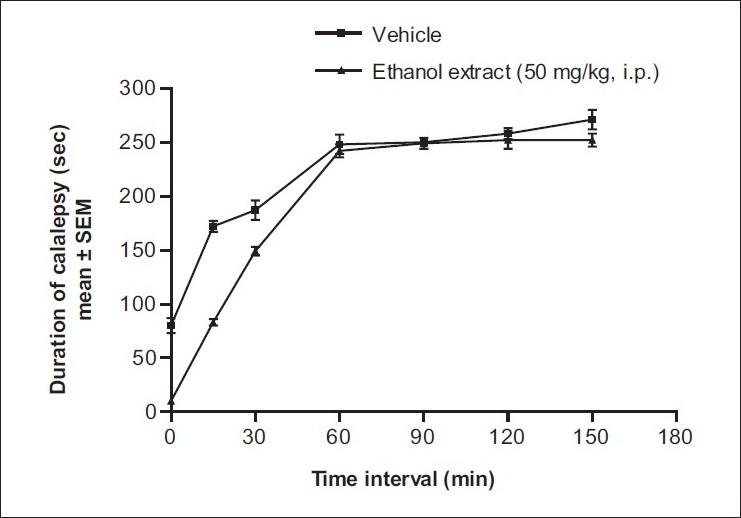Abstract
Bauhinia racemosa Lam. (Caesalpiniaceae) leaves have been used in the treatment of asthma traditionally and we therefore undertook this study to scientifically validate its benefit in asthma using suitable animal models. Antihistaminic principles are known to be useful in the treatment of asthma; hence, in the present work, the antihistaminic activity of an ethanol extract of B. racemosa (at a dose of 50 mg/kg, i.p.) was assessed using clonidine-induced catalepsy and haloperidol-induced catalepsy in Swiss albino mice. The results showed that the ethanol extract inhibits clonidine-induced catalepsy but there is no effect on haloperidol-induced catalepsy. This suggests that the inhibition is through an antihistaminic action and that there is no role of dopamine. Hence, we concluded that the ethanol extract has significant antihistaminic activity. The polar constituents in the ethanol extract of leaves of B. racemosa may be responsible for the antihistaminic activity and B. racemosa may therefore have a role in the treatment of asthma.
Keywords: Antihistaminic, asthma, Bauhinia racemosa, catalepsy, clonidine
INTRODUCTION
Bauhinia racemosa Lam. (Caesalpiniaceae) is a small bushy tree with drooping branches. The leaves are green and broader than long. The flowers are white or pale yellow, terminal or leaf-opposed racemes.[1–3] A new tetracyclic lupeol, betulin, β-sitosterol, and tetracyclic 2, 2-dimethyl chroman have been isolated from the roots.[4,5] The seed contains flavonoids, crude protein, and lipid.[6,7] A methanolic extract of the stem and bark are used as an anti-inflammatory, analgesic and antipyretic.[8] A methanolic extract of the flower buds is used in the treatment of peptic ulcer.[9] The whole plant is used as a veterinary medicine in central India. The present work was undertaken to evaluate the traditionally recognized antiasthmatic property of the leaves of B. racemosa.
Catalepsy is a condition in which the animal maintains an imposed posture for a long time before regaining its normal posture. Catalepsy is a sign of the extra-pyramidal effect of drugs that inhibit dopaminergic transmission or increase histamine release in brain. Clonidine, a α2 -adrenoceptor agonist, induces dose-dependent catalepsy in mice, which is inhibited by histamine H 1 -receptor antagonists but not by H 2 -receptor antagonists.[10]
In the present work we have attempted to evaluate the antihistaminic activity of the plant in order to assess if there is a basis for its traditional use in asthma.
MATERIALS AND METHODS
Plant material
The plant B racemosa was collected from Ahmednagar district (Maharashtra) in November, 2007, and authenticated by the Botanical Survey of India, Pune (Voucher specimen No. SCDBR1).
Animals
Male albino mice (Swiss strain) weighing 22-25 g were housed under standard laboratory conditions in groups of six each. The animals had free access to food and water. The ethics committee of the institute approved the protocol of the study.
Drugs and chemicals
The drugs used were: clonidine (Unichem, India), haloperidol (Sunpharma, India.), and pheniramine maleate (Pfizer Ltd.); all were purchased from a commercial source. Chemicals used were: ethanol AR (PCL, India) and Tween 80 AR (PCL, India).
Preparation of extract
The fresh leaves of B racemosa were shade-dried, crushed to produce a coarse powder, and subjected to extraction in a Soxhlet extractor using ethanol. The extract was filtered while hot and concentrated by vacuum distillation; it was then dried in open air to give a yield of 15.3% w/w.
Anticataleptic activity
Effect on clonidine-induced catalepsy: The bar test was used to study the effect of various extracts on clonidine-induced catalepsy.[11] Clonidine (1 mg/kg, s.c.) was injected into mice (n=6) pretreated 30 min before with vehicle (Tween 80 in distilled water; 5 mL/kg, p.o.) and ethanol extract (50 mg/kg, i.p.) or standard drug pheniramine maleate (10 mg/kg, i.p.) The dosages were selected based on an acute toxicity study (data not shown). The forepaws of mice were placed on a horizontal bar (1 cm in diameter, 3 cm above the table) and the time taken for the mouse to remove its paws from the bar was noted for each animal; the duration of catalepsy was measured at 0, 15, 30, 60, 90, 120, 150, and 180 min.
Effect on haloperidol-induced catalepsy: The same procedure was followed using haloperidol as the inducing agent.[11] Haloperidol (1 mg/kg, i.p.) was injected to mice (n=6) pretreated 30 min before with vehicle (Tween 80 in distilled water; 5 mL/kg, p.o.) or ethanol extract (50 mg/kg, i.p.). The duration of catalepsy was measured at 0, 15, 30, 60, 90, 120, 150, and 180 min.
Statistical analysis
The data are presentedas mean ± SEM. The data was analyzed by one-way ANOVA followed by Dunnet’s test. Prism Graph Pad 3 was used for statistical analysis. P<0.05 was considered significant.
RESULTS
The results show thattheethanol extract of leaves of B racemosa (50 mg/kg, i.p.) inhibits clonidine-inducedcatalepsy [Figure 1] but not haloperidol-induced catalepsy [Figure 2]. The inhibition of catalepsy was comparable with that with standard drug pheniramine maleate.
Figure 1.

Effect of ethanol extract of B. racemosa on clonidine-induced catalepsy in mice. *P<.05 compared to vehicle-treated group (one-way ANOVA followed by Dunnett’s test)
Figure 2.

Effect of various extract of B. racemosa on haloperidol-induced catalepsy in mice
DISCUSSION
Several drugs are known to induce catalepsy in animals. Chopra and Dandiya have studied the relative role of acetylcholine and histamine in perphenazine-induced catalepsy and suggested that the anticholinergic activity of antidepressants might be due to an increase in the dopamine content in brain or because of their ability to inhibit the release of acetylcholine.[12] The authors also showed that different stages of catalepsy appear to be directly correlated with brain histamine content. Uvnas studied mast cell degranulation and its correlation with the release of histamine after administration of a mast cell degranulating agent (Compound 48/80).[13] Lakdawala et al. have shown that clonidine releases histamine from mast cells in a similar manner to a selective liberator like compound 48/80.[14] They also showed that pretreatment with L-histidine, a precursor of histamine, potentiated clonidine-induced catalepsy in a dose-dependent manner. Muley et al. showed that intracerebroventricular injection of histamine in conscious mice induced catalepsy, which was inhibited by H1- receptor antagonist but not by H2 -receptor antagonist.[15] It is known that clonidine releases histamine from mast cells.[14] Schwatz identified histamine-containing mast cells in the brain.[16] Clonidine-induced release of histamine from mast cells is inhibited by the α2 -adrenoceptor blocker, prazosin.[17] Neuroleptic agents also induce catalepsy, but by a different mechanism: they inhibit dopamineD2 -receptors in substantia nigra.[18,19]
The findings of this study indicate that the ethanol extract of leaves of B. racemosa can inhibit clonidine-induced catalepsy but not haloperidol-induced catalepsy. From this study we can conclude that the cataleptic effect of clonidine in the mouse is mediated by histamine release from mast cells. The effect of this extract on clonidine-induced catalepsy is probably due to its mast cell-stabilizing property. The plant does not have activity on dopaminergic transmission. Thus the polar constituents may be useful as an antihistaminic and be used in the treatment of asthma.
Footnotes
Source of Support: Nil
Conflict of Interest: None declared.
REFERENCES
- 1.Nadkarni KM. 3rd ed. Vol. 1. Bombay: Bombay Popular Prakashan; 1982. Indian materia medica; p. 183. [Google Scholar]
- 2.Kirtikar KR, Basu BD. 2 nd ed. Vol. 3. Dehradun: Bishen Singh Mahendra Pal Singh; 1991. Indian Medicinal Plants; pp. 894–5. [Google Scholar]
- 3.New Delhi: Council of Scientific Research and Industrial Research; 1991. Anonymous. The Wealth of India; pp. 54–5. [Google Scholar]
- 4.Jain R, Alam S, Saxena UA. A new teteacyclic phenol and other constituents from the roots of Bauhinia racemosa. Indian J Chem. 2002;41:1321–2. [Google Scholar]
- 5.Prabhakar P, Gandhidasan R, Raman PV, Krishnasamy NR, Nanduri S. A tetracyclic 2,2-dimethyl chroman from the roots of Bauhinia racemosa. Phytochemistry. 1994;36:817–8. [Google Scholar]
- 6.Mohan VR, Janardhanan K. Chemical and nutritional evaluation of two germplasms of the tribal pulse, Bauhinia racemosa. Plant Foods Hum Nutr. 1994;96:367–74. doi: 10.1007/BF01088438. [DOI] [PubMed] [Google Scholar]
- 7.El-Hossary GA, Selim MA, Sayed AE, Khaleel AE. Cairo University: Bulletin of the Faculty of Pharmacy; 2000. Study of the flavonoid content of Bassia muricata and Bauhinia racemosa; p. 56. [Google Scholar]
- 8.Gupta M, Mazumdar UK, Kumar RS, Gomathi P, Rajishwar Y, Kakoti BB, et al. Anti-inflammatory, analgesic and antipyretic effects of methanol extract from Bauhinia racemosa stem bark in animal models. J Ethnopharmacol. 2005;98:267–73. doi: 10.1016/j.jep.2005.01.018. [DOI] [PubMed] [Google Scholar]
- 9.Akhtar AH, Ahmad KV. Anti-ulcerogenic evaluation of the methanolic extracts of some indigenous medicinal plants of Pakistan in aspirin-ulcerated rats. J Ethnopharmacol. 1995;46:1–6. doi: 10.1016/0378-8741(94)01220-t. [DOI] [PubMed] [Google Scholar]
- 10.Jadhav JH, Balsara JJ, Chandorkar AG. Involvement of histaminergic mechanisms in the cataleptogenic effect of clonidine in mice. J Pharm Pharmacol. 1983;35:671–3. doi: 10.1111/j.2042-7158.1983.tb02864.x. [DOI] [PubMed] [Google Scholar]
- 11.Ferre S, Guix T, Prat G. Is experimental catalepsy properly measured? Pharmacol Biochem Behav. 1990;35:753–7. doi: 10.1016/0091-3057(90)90354-k. [DOI] [PubMed] [Google Scholar]
- 12.Chopra YM, Dandiya PC. The relative role of brain acetylcholine and histamine in perphenazine catatonia and influence of antidepressants and diphenhydramine alone and in combination. Neuropharmacology. 1975;14:555–60. doi: 10.1016/0028-3908(75)90120-3. [DOI] [PubMed] [Google Scholar]
- 13.Uvans B. Mast cells and histamine release. Indian J Pharmacol. 1969;1:23–32. [Google Scholar]
- 14.Lakadwala AD, Dadkar NK, Dohadwala AN. Action of clonidine on mast cells of rats. J Pharm Pharmacol. 1980;32:790–1. doi: 10.1111/j.2042-7158.1980.tb13070.x. [DOI] [PubMed] [Google Scholar]
- 15.Mulay MP, Balsara JJ, Chandorkar AG. Intarcerebroventricular administration of histamine in conscious mice during catalepsy. Indian J Pharmacol. 1979;11:277–81. [Google Scholar]
- 16.Schwartz JC, Elliot HW, George R, Okun R. Annual review of Pharmacology and Toxicology. In: Elliot HW, George R, Okun R, editors. Palo Alto: Ann Reviews Inc; 1997. pp. 325–39. [Google Scholar]
- 17.Weiner N. Drugs that inhibit adrenergic nerves and block adrenergic receptors. In: Gilman AG, Goodman LS, editors. The Pharmacological Basis of Therapeutics. 7th ed. New York: Macmillan Publishing Co; 1985. pp. 176–10. [Google Scholar]
- 18.Sanberg PR. Haloperidol induced catalepsy is mediated by postsynaptic dopamine receptor. Nature. 1980;284:472–3. doi: 10.1038/284472a0. [DOI] [PubMed] [Google Scholar]
- 19.Ossowska K, Karcz M, Wardas J. Straiatal and nucleus accumbens D1 /D2 dopamine receptors in neuroleptic catalepsy. Eur J Pharmacol. 1990;182:327–34. doi: 10.1016/0014-2999(90)90291-d. [DOI] [PubMed] [Google Scholar]


